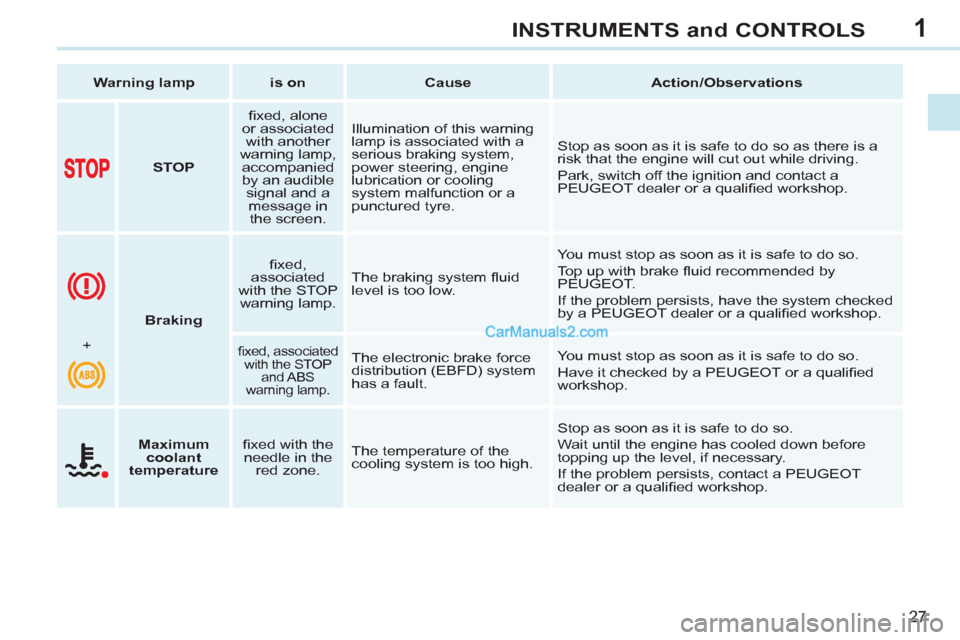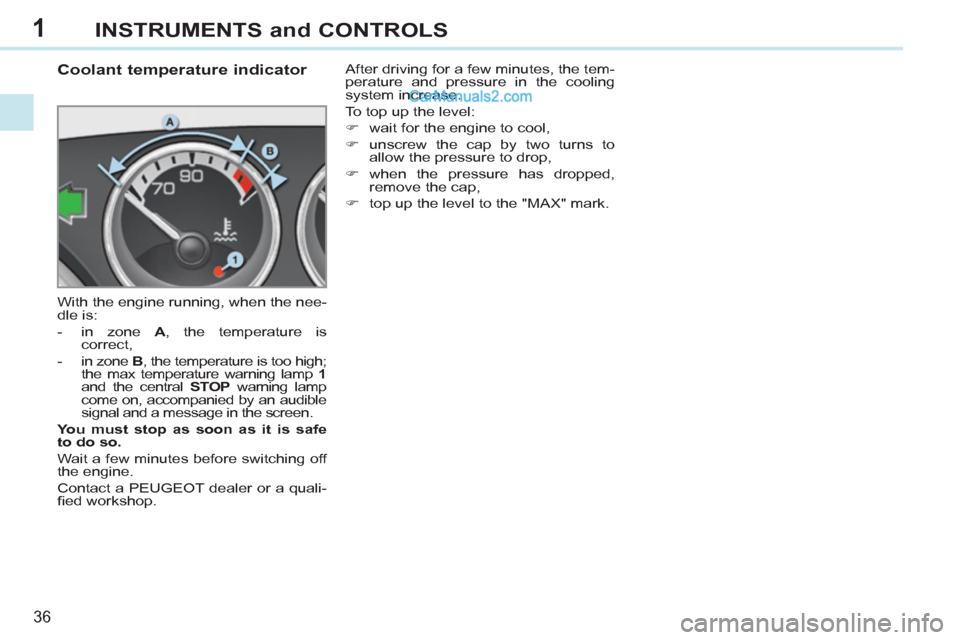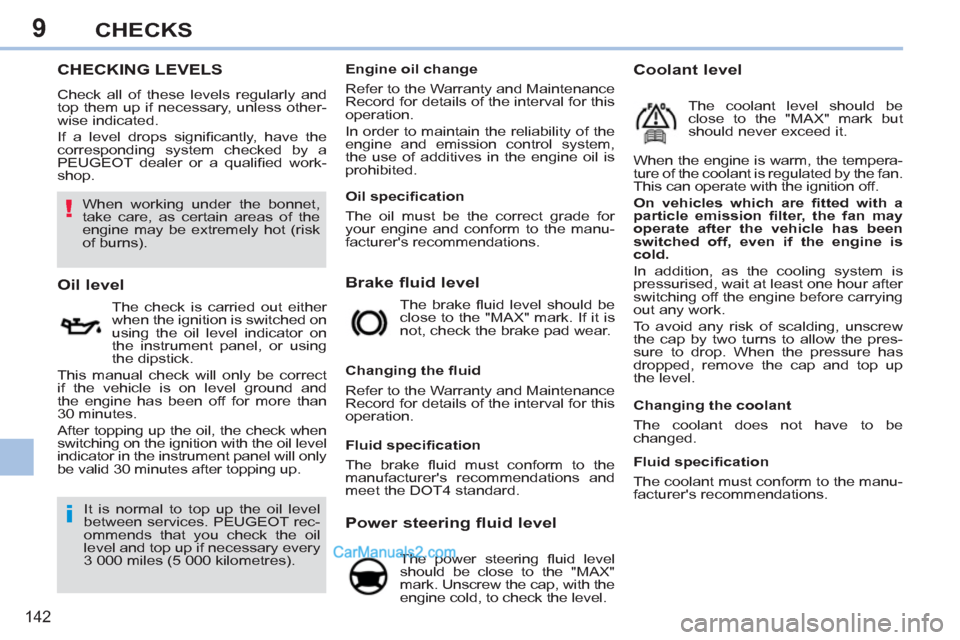2011 Peugeot 308 CC coolant
[x] Cancel search: coolantPage 24 of 292

1
i
22
INSTRUMENTS and CONTROLS
PETROL - DIESEL MANUAL OR AUTOMATIC GEARBOX
INSTRUMENT PANELS
Panel grouping together the vehicle
operation indication dials and warning
lamps.
5.
Screen.
6.
Control button.
Recalls the service information.
Resets the function to zero (trip dis-
tance recorder or service indicator).
7.
Instrument panel lighting
dimmer
.
Adjusts the brightness of the lighting
of the instruments and controls.
Dials
1.
Rev counter.
Indicates the speed of rotation of
the engine (x 1 000 rpm).
2.
Coolant temperature.
Indicates the temperature of the
engine coolant (°Celsius).
3.
Fuel level.
Indicates the quantity of fuel remain-
ing in the tank.
4.
Vehicle speed.
Indicates the current speed of the
moving vehicle (mph or km/h).
A.
Speed limiter
(mph or km/h) or
Cruise control.
B.
Gear shift indicator.
C.
Automatic gearbox.
D.
Trip distance recorder.
(miles or km)
E.
Service indicator.
(miles or km) then,
engine oil level indicator
then
distance recorder.
(miles or km)
These three functions are displayed
in succession when the ignition is
switched on.
Displays
For more information, refer to the
paragraph relating to the button or
function and its associated display.
Page 25 of 292

1
i
23
INSTRUMENTS and CONTROLS
PETROL - DIESEL MANUAL OR AUTOMATIC GEARBOX
INSTRUMENT PANELS
Panel grouping together the vehicle
operation indication dials and warning
lamps.
5.
Small screen.
6.
Central screen.
7.
Control button.
Starts a manual CHECK and recalls
the service information.
Resets the function to zero (trip dis-
tance recorder or service indicator).
8.
Instrument panel lighting
dimmer
Adjusts the brightness of the lighting
of the instruments and controls.
Dials
1.
Rev counter.
Indicates the speed of rotation of the
engine (x 1 000 rpm).
2.
Coolant temperature.
Indicates the temperature of the
engine coolant (° Celsius).
3.
Fuel level.
Indicates the quantity of fuel remain-
ing in the tank.
4.
Vehicle speed.
Indicates the current speed of the
moving vehicle (mph or km/h).
A.
Trip distance recorder.
(miles or km)
B.
Distance recorder.
(miles or km)
C.
Engine oil level indicator,
service indicator.
(miles or km)
These two functions are displayed
when the ignition is switched on,
then disappear after a few seconds.
Displays
For more information, refer to the
paragraph which relates to the but-
ton or function and its associated
display. The following functions are displayed in
accordance with the selection.
- Warning lamps/CHECK.
- Tyre under-infl ation detection.
- Speed limiter/Cruise control.
- Gear shift indicator.
- Automatic gearbox.
-
Navigation - Guidance/Trip computer.
Page 26 of 292

1
i
24
INSTRUMENTS and CONTROLS
PETROL - DIESEL MANUAL OR AUTOMATIC GEARBOX PEUGEOT
CONNECT MEDIA INSTRUMENT PANELS
Panel grouping together the vehicle
operation indication dials and warning
lamps.
5.
Small screen.
6.
Central screen.
7.
Control button.
Starts a manual CHECK and recalls
the service information.
Resets the function to zero (trip dis-
tance recorder or service indicator).
8.
Instrument panel lighting
dimmer
.
Adjusts the brightness of the lighting
of the instruments and controls.
Dials
1.
Rev counter.
Indicates the speed of rotation of the
engine (x 1 000 rpm).
2.
Coolant temperature.
Indicates the temperature of the
engine coolant (°Celsius).
3.
Fuel level.
Indicates the quantity of fuel remain-
ing in the tank.
4.
Vehicle speed.
Indicates the current speed of the
moving vehicle (mph or km/h).
A.
Trip distance recorder.
(miles or km)
B.
Distance recorder.
(miles or km)
C.
Engine oil level indicator,
se
rvice indicator.
(miles or km)
These two functions are displayed
when the ignition is switched on,
then disappear after a few seconds.
Displays
For further information, refer to the
paragraph which relates to the but-
ton or function and its associated
display. The following functions are displayed in
accordance with the selection.
- Warning lamps/CHECK.
- Tyre under-infl ation detection.
- Speed limiter/Cruise control.
- Gear shift indicator.
- Automatic gearbox.
-
Navigation - Guidance/Trip computer.
- Vehicle parameters.
Page 29 of 292

1
27
INSTRUMENTS and CONTROLS
Warning lamp
is on
Cause
Action/Observations
STOP
fi xed, alone
or associated
with another
warning lamp,
accompanied
by an audible
signal and a
message in
the screen. Illumination of this warning
lamp is associated with a
serious braking system,
power steering, engine
lubrication or cooling
system malfunction or a
punctured tyre. Stop as soon as it is safe to do so as there is a
risk that the engine will cut out while driving.
Park, switch off the ignition and contact a
PEUGEOT dealer or a qualifi ed workshop.
Braking
fi xed,
associated
with the STOP
warning lamp. The braking system fl uid
level is too low. You must stop as soon as it is safe to do so.
Top up with brake fl uid recommended by
PEUGEOT.
If the problem persists, have the system checked
by a PEUGEOT dealer or a qualifi ed workshop.
+
fi xed, associated
with the STOP
and ABS
warning lamp.
The electronic brake force
distribution (EBFD) system
has a fault. You must stop as soon as it is safe to do so.
Have it checked by a PEUGEOT or a qualifi ed
workshop.
Maximum
coolant
temperature
fi xed with the
needle in the
red zone. The temperature of the
cooling system is too high. Stop as soon as it is safe to do so.
Wait until the engine has cooled down before
topping up the level, if necessary.
If the problem persists, contact a PEUGEOT
dealer or a qualifi ed workshop.
Page 38 of 292

1
36
INSTRUMENTS and CONTROLS
Coolant temperature indicator
With the engine running, when the nee-
dle is:
- in zone A
, the temperature is
correct,
- in zone B
, the temperature is too high;
the max temperature warning lamp 1
and the central STOP
warning lamp
come on, accompanied by an audible
signal and a message in the screen.
You must stop as soon as it is safe
to do so.
Wait a few minutes before switching off
the engine.
Contact a PEUGEOT dealer or a quali-
fi ed workshop. After driving for a few minutes, the tem-
perature and pressure in the cooling
system increase.
To top up the level:
�)
wait for the engine to cool,
�)
unscrew the cap by two turns to
allow the pressure to drop,
�)
when the pressure has dropped,
remove the cap,
�)
top up the level to the "MAX" mark.
Page 142 of 292

9
140
CHECKS
PETROL ENGINES
The various caps and covers allow
access for checking the levels of the
various fl uids and for replacing certain
components.
1.
Power steering reservoir.
2.
Screenwash and headlamp wash
reservoir.
3.
Coolant reservoir.
4.
Brake fl uid reservoir.
5.
Battery/Fuses.
6.
Fusebox.
7.
Air fi lter.
8.
Engine oil dipstick.
9.
Engine oil fi ller cap.
Page 143 of 292

9
141
CHECKS
DIESEL ENGINES
The various caps and covers allow ac-
cess for checking the levels of the various
fl uids, for replacing certain components
and for priming the fuel system.
1.
Power steering reservoir.
2.
Screenwash and headlamp wash
reservoir.
3.
Coolant reservoir.
4.
Brake fl uid reservoir.
5.
Battery/Fuses.
6.
Fusebox.
7.
Air fi lter.
8.
Engine oil dipstick.
9.
Engine oil fi ller cap.
10.
Priming pump * .
11 .
Bleed screw * .
* According to engine.
Page 144 of 292

9
!
i
142
CHECKS
CHECKING LEVELS
Check all of these levels regularly and
top them up if necessary, unless other-
wise indicated.
If a level drops signifi cantly, have the
corresponding system checked by a
PEUGEOT dealer or a qualifi ed work-
shop.
Brake fluid level
Oil level
The check is carried out either
when the ignition is switched on
using the oil level indicator on
the instrument panel, or using
the dipstick.
This manual check will only be correct
if the vehicle is on level ground and
the engine has been off for more than
30 minutes.
After topping up the oil, the check when
switching on the ignition with the oil level
indicator in the instrument panel will only
be valid 30 minutes after topping up. The brake fl uid level should be
close to the "MAX" mark. If it is
not, check the brake pad wear.
Power steering fluid level
The power steering fl uid level
should be close to the "MAX"
mark. Unscrew the cap, with the
engine cold, to check the level.
It is normal to top up the oil level
between services. PEUGEOT rec-
ommends that you check the oil
level and top up if necessary every
3 000 miles (5 000 kilometres).
Changing the fl uid
Refer to the Warranty and Maintenance
Record for details of the interval for this
operation. When the engine is warm, the tempera-
ture of the coolant is regulated by the fan.
This can operate with the ignition off.
On vehicles which are fi tted with a
particle emission fi lter, the fan may
operate after the vehicle has been
switched off, even if the engine is
cold.
In addition, as the cooling system is
pressurised, wait at least one hour after
switching off the engine before carrying
out any work.
To avoid any risk of scalding, unscrew
the cap by two turns to allow the pres-
sure to drop. When the pressure has
dropped, remove the cap and top up
the level.
Coolant level
The coolant level should be
close to the "MAX" mark but
should never exceed it.
Changing the coolant
The coolant does not have to be
changed.
When working under the bonnet,
take care, as certain areas of the
engine may be extremely hot (risk
of burns).
Fluid specifi cation
The coolant must conform to the manu-
facturer's recommendations.
Fluid specifi cation
The brake fl uid must conform to the
manufacturer's recommendations and
meet the DOT4 standard.
Oil specifi cation
The oil must be the correct grade for
your engine and conform to the manu-
facturer's recommendations.
Engine oil change
Refer to the Warranty and Maintenance
Record for details of the interval for this
operation.
In order to maintain the reliability of the
engine and emission control system,
the use of additives in the engine oil is
prohibited.